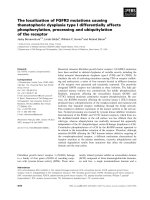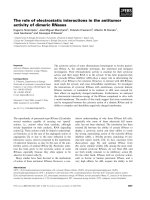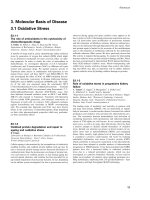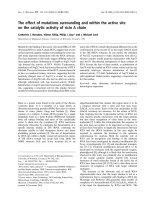Báo cáo khoa học: "The Contribution of Stylistic Information to Content-based Mobile Spam Filtering" potx
Bạn đang xem bản rút gọn của tài liệu. Xem và tải ngay bản đầy đủ của tài liệu tại đây (362.13 KB, 4 trang )
Proceedings of the ACL-IJCNLP 2009 Conference Short Papers, pages 321–324,
Suntec, Singapore, 4 August 2009.
c
2009 ACL and AFNLP
The Contribution of Stylistic Information to
Content-based Mobile Spam Filtering
Dae-Neung Sohn and Jung-Tae Lee and Hae-Chang Rim
Department of Computer and Radio Communications Engineering
Korea University
Seoul, 136-713, South Korea
{danny,jtlee,rim}@nlp.korea.ac.kr
Abstract
Content-based approaches to detecting
mobile spam to date have focused mainly
on analyzing the topical aspect of a SMS
message (what it is about) but not on the
stylistic aspect (how it is written). In this
paper, as a preliminary step, we investigate
the utility of commonly used stylistic fea-
tures based on shallow linguistic analysis
for learning mobile spam filters. Experi-
mental results show that the use of stylis-
tic information is potentially effective for
enhancing the performance of the mobile
spam filters.
1 Introduction
Mobile spam, also known as SMS spam, is a sub-
set of spam that involves unsolicited advertising
text messages sent to mobile phones through the
Short Message Service (SMS) and has increas-
ingly become a major issue from the early 2000s
with the popularity of mobile phones. Govern-
ments and many service providers have taken var-
ious countermeasures in order to reduce the num-
ber of mobile spam (e.g. by imposing substantial
fines on spammers, blocking specific phone num-
bers, creating an alias address, etc.). Nevertheless,
the rate of mobile spam continues to rise.
Recently, a more technical approach to mobile
spam filtering based on the content of a SMS mes-
sage has started gaining attention in the spam re-
search community. G
´
omez Hidalgo et al. (2006)
previously explored the use of statistical learning-
based classifiers trained with lexical features, such
as character and word n-grams, for mobile spam
filtering. However, content-based spam filtering
directed at SMS messages are very challenging,
due to the fact that such messages consist of only
a few words. More recent studies focused on ex-
panding the feature set for learning-based mobile
spam classifiers with additional features, such as
orthogonal sparse word bi-grams (Cormack et al.,
2007a; Cormack et al., 2007b).
Collectively, the features exploited in earlier
content-based approach to mobile spam filtering
are topical terms or phrases that statistically in-
dicate the spamness of a SMS message, such as
“loan” or “70% off sale”. However, there is
no guarantee that legitimate (non-spam) messages
would not contain such expressions. Any of us
may send a SMS message such as “need ur ad-
vise on private loans, plz call me” or “mary,
abc.com is having 70% off sale today”. For cur-
rent content-based mobile spam filters, there is a
chance that they would classify such legitimate
messages as spam. This motivated us to not only
rely on the message content itself but incorporate
new features that reflect its “style,” the manner in
which the content is expressed, in mobile spam fil-
tering.
The main goal of this paper is to investigate the
potential of stylistic features in improving the per-
formance of learning-based mobile spamfilters. In
particular, we adopt stylistic features previously
suggested in authorship attribution studies based
on stylometry, the statistical analysis of linguistic
style.
1
Our assumption behind adopting the fea-
tures from authorship attribution are as follows:
• There are two types of SMS message senders,
namely spammers and non-spammers.
• Spammers have distinctive linguistic styles
and writing behaviors (as opposed to non-
spammers) and use them consistently.
• The SMS message as an end product carries
the author’s “fingerprints”.
1
Authorship attribution involves identifying the author of
a text given some stylistic characteristics of authors’ writing.
See Holmes (1998) for overview.
321
Although there are many types of stylistic fea-
tures suggested in the literature, we make use of
the ones that are readily computable and countable
from SMS message texts without any complex lin-
guistic analysis as a preliminary step, including
word and sentence lengths (Mendenhall, 1887),
frequencies of function words (Mosteller and Wal-
lace, 1964), and part-of-speech tags and tag n-
grams (Argamon-Engelson et al., 1998; Koppel et
al., 2003; Santini, 2004).
Our experimental result on a large-scale, real
world SMS dataset demonstrates that the newly
added stylistic features effectively contributes to
statistically significant improvement on the perfor-
mance of learning-based mobile spam filters.
2 Stylistic Feature Set
All stylistic features listed below have been auto-
matically extracted using shallow linguistic analy-
sis. Note that most of them have been motivated
from previous stylometry studies.
2.1 Length features: LEN
Mendenhall (1887) first created the idea of count-
ing word lengths to judge the authorship of texts,
followed by Yule (1939) and Morton (1965) with
the use of sentence lengths. In this paper, we mea-
sure the overall byte length of SMS messages and
the average byte length of words in the message as
features.
2.2 Function word frequencies: FW
Motivated from a number of stylometry studies
based on function words including Mosteller and
Wallace (1964), Tweedie et al. (1996) and Arg-
amon and Levitan (2005), we measure the fre-
quencies of function words in SMS messages as
features. The intuition behind function words is
that due to their high frequency in languages and
highly grammaticalized roles, such words are un-
likely to be subject to conscious control by the au-
thor and that the frequencies of different function
words would vary greatly across different authors
(Argamon and Levitan, 2005).
2.3 Part-of-speech n-grams: POS
Following the work of Argamon-Engelson et al.
(1998), Koppel et al. (2003), Santini (2004) and
Gamon (2004), we extract part-of-speech n-grams
(up to trigrams) from the SMS messages and use
their frequencies as features. The idea behind their
utility is that spammers would favor certain syn-
tactic constructions in their messages.
2.4 Special characters: SC
We have observed that many SMS messages con-
tain special characters and that their usage varies
between spam and non-spam messages. For in-
stance, non-spammers often use special characters
to create emoticons to express their mood, such as
“:-)” (smiling) or “T T” (crying), whereas spam-
mers tend to use special character or patterns re-
lated to monetary matters, such as “$$$” or “%”.
Therefore, we also measured the ratio of special
characters, the number of emoticons, and the num-
ber of special character patterns in SMS messages
as features.
2
3 Learning a Mobile Spam Filter
In this paper, we use maximum entropy model,
which have shown robust performance in various
text classification tasks in the literature, for learn-
ing the mobile spam filter. Simply put, given a
number of training samples (in our case, SMS
messages), each with a label Y (where Y = 1 if
spam and 0 otherwise) and a feature vector x, the
filter learns a vector of feature weight parameters
w. Given a test sample X with its feature vector x,
the filer outputs the conditional probability of pre-
dicting the data as spam, P(Y = 1|X = x). We
use the L-BFGS algorithm (Malouf, 2002) and the
Information Gain (IG) measure for parameter esti-
mation and feature selection, respectively.
4 Experiments
4.1 SMS test collections
We use a collection of mobile SMS messages in
Korean, with 18,000 (60%) legitimate messages
and 12,000 (40%) spam messages. This collec-
tion is based on one used in our previous work
(Sohn et al., 2008) augmented with 10,000 new
messages. Note that the size is approximately 30
times larger than the most previous work by Cor-
mack et al. (2007a) on mobile spam filtering.
4.2 Feature setting
We compare three types of feature sets, as follows:
2
For emoticon and special pattern counts, we used man-
ually constructed lexicons consisting of 439 emoticons and
229 special patterns.
322
• Baseline: This set consists of lexical features
in SMS messages, including words, charac-
ter n-grams, and orthogonal sparse word bi-
grams (OSB)
3
. This feature set represents
the content-based approaches previously pro-
posed by G
´
omez Hidalgo et al. (2006), Cor-
mack et al. (2007a) and Cormack et al.
(2007b).
• Proposed: This feature set consists of all the
stylistic features mentioned in Section 2.
• Combined: This set is a combination of both
the baseline and proposed feature sets.
For all three sets, we make use of 100 features with
the highest IG values.
4.3 Evaluation measures
Since spam filtering task is very sensitive to false-
positives (i.e. legitimate classified as spam) and
false-negatives (i.e. spam classified as legitimate),
special care must be taken when choosing an ap-
propriate evaluation criterion.
Following the TREC Spam Track, we evalu-
ate the filters using ROC curves that plot false-
positive rate against false-negative rate. As a sum-
mary measure, we report one minus area under
the ROC curve (1−AUC) as a percentage with
confidence intervals, which is the TREC’s official
evaluation measure.
4
Note that lower 1−AUC(%)
value means better performance. We used the
TREC Spam Filter Evaluation Toolkit
5
in order to
perform the ROC analysis.
4.4 Results
All experiments were performed using 10-fold
cross validation. Statistical significance of differ-
ences between results were computed with a two-
tailed paired t-test. The symbol † indicates statis-
tical significance over an appropriate baseline at
p < 0.01 level.
Table 1 reports the 1−AUC(%) summary for
each feature settings listed in Section 4.2. Notice
that Proposed achieves significantly better perfor-
mance than Baseline. (Recall that the smaller, the
3
OSB refers to words separated by 3 or fewer words,
along with an indicator of the difference in word positions;
for example, the expression “the quick brown fox” would
induce following OSB features: “the (0) quick”, “the (1)
brown”, “the (2) fox”, “quick (0) brown”, “quick (1) fox”,
and “brown (0) fox” (Cormack et al., 2007a).
4
For detail on ROC analysis, see Cormack et al. (2007a).
5
Available at />Feature set 1−AUC (%)
Baseline 10.7227 [9.4476 - 12.1176]
Proposed 4.8644
†
[4.2726 - 5.5886]
Combined 3.7538
†
[3.1186 - 4.4802]
Table 1: Performance of different feature settings.
50.00
10.00
1.00
50.0010.001.000.100.01
False Negative Rate(logit scale)
False Positve Rate (logit scale)
Combined
Proposed
Baseline
Figure 1: ROC curves of different feature settings.
better.) An even greater performance gain is ob-
tained by combining both Proposed and Baseline.
This clearly indicates that stylistic aspects of SMS
messages are potentially effective for mobile spam
filtering.
Figure 1 shows the ROC curves of each fea-
ture settings. Notice the tradeoff when Proposed
is used solely with comparison to Baseline; false-
positive rate is worsened in return for gaining bet-
ter false-negative rate. Fortunately, when both fea-
ture sets are combined, false-positive rate is re-
mained unchanged while the lowest false-negative
rate is achieved. This suggests that the addition of
stylistic features contributes to the enhancement of
false-negative rate while not hurting false-positive
rate (i.e. the cases where spam is classified as le-
gitimate are significantly lessened).
In order to evaluate the contribution of different
types of stylistic features, we conducted a series
of experiments by removing features of a specific
type at a time from Combined. Table 2 shows the
detailed result. Notice that LEN and SC features
are the most helpful, since the performance drops
significantly after removing either of them. Inter-
estingly, FW and POS features show similar con-
tributions; we suggest that these two feature types
have similar effects in this filtering task.
We also conducted another series of experi-
ments, by adding one feature type at a time to
Baseline. Table 3 reports the results. Notice that
LEN features are consistently the most helpful.
The most interesting result is that POS features
continuously contributes the least. We carefully
323
Feature set 1−AUC (%)
Combined 3.7538 [3.1186 - 4.4802]
− LEN 4.7351
†
[4.0457 - 5.6405]
− FW 3.9823
†
[3.3048 - 4.5930]
− POS 4.0712
†
[3.4057 - 4.8630]
− SC 4.7644
†
[4.1012 - 5.4350]
Table 2: Performance by removing one stylistic
feature set from the Combined set.
Feature set 1−AUC (%)
Baseline 10.7227 [9.4476 - 12.1176]
+ LEN 5.5275
†
[4.0457 - 6.6281]
+ FW 6.0828
†
[5.1783 - 6.9249]
+ POS 9.6103
†
[8.7190 - 11.0579]
+ SC 7.5288
†
[6.6049 - 8.4466]
Table 3: Performance by adding one stylistic fea-
ture set to the Baseline set.
hypothesize that the result is due to high depen-
dencies between POS and lexical features.
5 Discussion
In this paper, we have introduced new features that
indicate the written style of texts for content-based
mobile spam filtering. We have also shown that the
stylistic features are potentially useful in improv-
ing the performance of mobile spam filters.
This is definitely a work in progress, and much
more experimentation is required. Deep linguis-
tic analysis-based stylistic features, such as con-
text free grammar production frequencies (Ga-
mon, 2004) and syntactic rewrite rules in an au-
tomatic parse (Baayen et al., 1996), that have al-
ready been successfully used in the stylometry lit-
erature may be considered. Perhaps most impor-
tantly, the method must be tested on various mo-
bile spam data sets written in languages other than
Korean. These would be our future work.
References
Shlomo Argamon and Shlomo Levitan. 2005. Measur-
ing the usefulness of function words for authorship
attribution. In Proceedings of ACH/ALLC ’05.
Shlomo Argamon-Engelson, Moshe Koppel, and Galit
Avneri. 1998. Style-based text categorization:
What newspaper am i reading? In Proceedings of
AAAI ’98 Workshop on Text Categorization, pages
1–4.
H. Baayen, H. van Halteren, and F. Tweedie. 1996.
Outside the cave of shadows: using syntactic annota-
tion to enhance authorship attribution. Literary and
Linguistic Computing, 11(3):121–132.
Gordon V. Cormack, Jos
´
e Mar
´
ıa G
´
omez Hidalgo, and
Enrique Puertas S
´
anz. 2007a. Spam filtering for
short messages. In Proceedings of CIKM ’07, pages
313–320.
Gordon V. Cormack, Jos
´
e Mar
´
ıa G
´
omez Hidalgo, and
Enrique Puertas S
´
anz. 2007b. Feature engineering
for mobile (sms) spam filtering. In Proceedings of
SIGIR ’07, pages 871–872.
Michael Gamon. 2004. Linguistic correlates of style:
Authorship classification with deep linguistic analy-
sis features. In Proceedings of COLING ’04, page
611.
Jos
´
e Mar
´
ıa G
´
omez Hidalgo, Guillermo Cajigas
Bringas, Enrique Puertas S
´
anz, and Francisco Car-
rero Garc
´
ıa. 2006. Content based sms spam filter-
ing. In Proceedings of DocEng ’06, pages 107–114.
David I. Holmes. 1998. The evolution of stylometry
in humanities scholarship. Literary and Linguistic
Computing, 13(3):111–117.
Moshe Koppel, Shlomo Argamon, and Anat R. Shi-
moni. 2003. Automatically categorizing written
texts by author gender. Literary and Linguistic
Computing, 17(4):401–412.
Robert Malouf. 2002. A comparison of algorithms
for maximum entropy parameter estimation. In Pro-
ceedings of COLING ’02, pages 1–7.
T. C. Mendenhall. 1887. The characteristic curves of
composition. Science, 9(214):237–246.
A. Q. Morton. 1965. The authorship of greek prose.
Journal of the Royal Statistical Society Series A
(General), 128(2):169–233.
Frederick Mosteller and David L. Wallace. 1964. In-
ference and Disputed Authorship: The Federalist.
Addison-Wesley.
Marina Santini. 2004. A shallow approach to syntactic
feature extraction for genre classification. In Pro-
ceedings of CLUK Colloquium ’04.
Dae-Neung Sohn, Joong-Hwi Shin, Jung-Tae Lee,
Seung-Wook Lee, and Hae-Chang Rim. 2008.
Contents-based korean sms spam filtering using
morpheme unit features. In Proceedings of HCLT
’08, pages 194–199.
E. J. Tweedie, S. Singh, and D. I. Holmes. 1996. Neu-
ral network applications in stylometry: The federal-
ist papers. Computers and the Humanities, 30:1–10.
G. Udny Yule. 1939. On sentence-length as a statisti-
cal characteristic of style in prose, with application
to two cases of disputed authorship. Biometrika,
30(3-4):363–390.
324
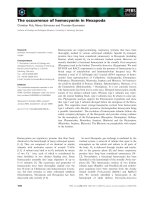
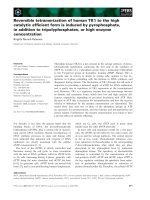
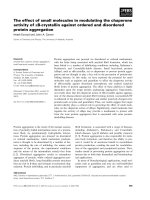
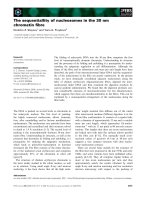
![Tài liệu Báo cáo khoa học: The stereochemistry of benzo[a]pyrene-2¢-deoxyguanosine adducts affects DNA methylation by SssI and HhaI DNA methyltransferases pptx](https://media.store123doc.com/images/document/14/br/gc/medium_Y97X8XlBli.jpg)
